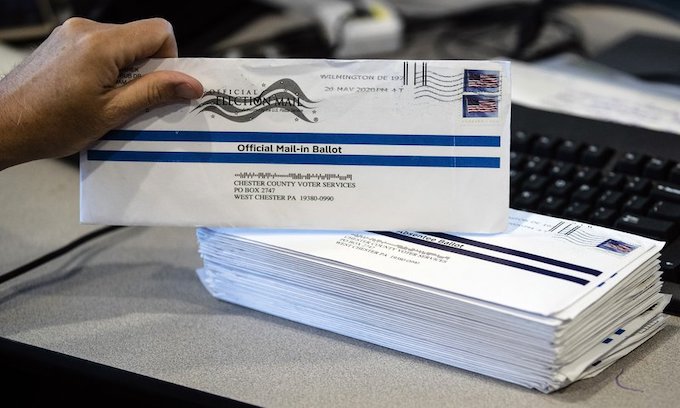Printing mistakes will force local election officials in Pennsylvania and Oregon to redo thousands of mailed ballots, a laborious process that could delay results for some closely contested races in Tuesday’s primaries.
In Pennsylvania, where GOP primaries for governor and U.S. Senate are drawing national attention, officials in Republican-leaning Lancaster County said the company that printed its mailed ballots included the wrong ID code, preventing scanning machines from being able to read them. The problem involved at least 21,000 mailed ballots, only a third of which were scanning properly.
The glitch will force election workers to hand-mark fresh ballots, a process expected to take several days. Officials in the county, the state’s sixth most populous, pledged that all the ballots will be counted eventually.
“Citizens deserve to have accurate results from elections and they deserve to have them on election night, not days later,” Josh Parsons, a Republican and vice chair of the county board of commissioners, said at a news conference. “But because of this, we’re not going to have final election results from these mail ballots for probably several days, so that is very, very frustrating to us.”
Related Story: Pennsylvania Senate Race Turns on 21,000 Unscanned Mail-In Ballots
In Oregon, where all registered voters receive a mailed ballot, officials in one politically pivotal county are dealing with a similar problem. About half the ballots sent to voters in Clackamas County, the state’s third most populous, included a blurry bar code that cannot be read by ballot-scanning machines.
Teams that include both Democrats and Republicans are duplicating every ballot so they can be scanned. Ben Morris, a spokesman for the secretary of state’s office, said the results could be delayed but will be accurate.
Clackamas County includes part of Oregon’s new 6th Congressional District, formed after the state gained a U.S. House seat following the 2020 census. It also includes the newly redrawn 5th Congressional District, where incumbent Democratic Rep. Kurt Schrader is facing a strong primary challenge from Jamie McLeod-Skinner, an attorney and former city planner who is aligned with the party’s progressives.
The newly drawn district is more conservative than the previous one, leading some Democrats to worry that a McLeod-Skinner victory will imperil Democrat’s chances of retaining the seat in the fall.
In a statement released by the campaign, McLeod-Skinner said of the possible vote-counting problems: “Now more than ever, it’s important that we respect the integrity of our elections. We know the ballots may take additional time to be counted and we respect the state’s process. What matters most is that every Oregonian’s vote is counted.”
Pennsylvania and Oregon were among five states holding primaries Tuesday, along with Idaho, Kentucky and North Carolina, where slight morning delays had been reported at polling places in three counties.
The mailed ballot misprint was just one of several voting problems to flare up on Election Day across Pennsylvania, a state where former President Donald Trump disputed his loss to Joe Biden in 2020 and where many Republican lawmakers have repeated his false claims of a stolen election.
In Pittsburgh’s Allegheny County, higher-than-expected turnout led some polling places to run low on ballots.
County spokeswoman Amie Downs said she could not confirm reports that some voters had been turned away, but said all polling locations that needed extra ballots had received them.
Allegheny County Councilman Sam DeMarco, who also serves as an election commissioner and county GOP chair, said the situation added to concerns some Republicans have about the voting process.
“It’s just giving them more reason to doubt the integrity of the election, and they can feel that things are against them,” he said.
County Councilwoman Bethany Hallam, a Democrat who also serves as an election commissioner, said the ballot shortages were affecting both Republican and Democratic primary voters.
“Elections Division does its best to predict turnout at each of the 1,323 precincts in Allegheny County, but it’s not an exact science,” Hallam said. “We’ll use the reported shortages from this election to better predict how many to provide for the next election and work hard to prevent it from happening in the future.”
In Berks County, Pennsylvania, a judge ruled Tuesday that all polling places would remain open an hour later, until 9 p.m. Eastern, after several locations experienced technical issues with electronic pollbooks that are used to check in voters. Voters who arrive at polling places after 8 p.m. will have to cast provisional ballots rather than using voting machines.
The wrongly coded mail ballots in Lancaster County drew renewed attention to a 2019 state voting law — passed with bipartisan support — that greatly expanded voting by mail, a frequent Trump target.
Local election officials throughout the state have criticized several of the law’s restrictions, especially one that prevents them from processing mailed ballots before Election Day. That would allow counties to get a head-start on validating those ballots and start identifying any errors.
The Lancaster County board chairman, Ray D’Agostino, called the law “untenable” for counties trying to run elections.
County officials said the contractor, Claysburg, Pennsylvania-based NPC, sent the county test ballots with the correct ID code, but used the wrong code on the ones sent to voters. NPC did not immediately respond to a message seeking comment, but D’Agostino said the company had taken “full responsibility.”
Pennsylvania Department of State spokesperson Ellen Lyon said no other counties had reported similar issues.
County election workers now must recreate voters’ choices on blank ballots. Lancaster County, which went for Trump by about 16 percentage points over Biden in the 2020 presidential contest, had to use a similar process during primaries last year because of a printing error by a different vendor that was later fired.
Christa Miller, chief clerk of voter registration, said an elections worker will read out each voter’s choices, a second worker will record them on a blank ballot, and an observer will make sure the choices are marked correctly.
“Our main priority is accuracy and not how fast we can do something,” she said.
___
Associated Press writers Gillian Flaccus in Portland, Oregon, and Chris Grygiel in Seattle contributed to this report.
© 2022 The Canadian Press. All rights reserved.
—-
This content is published through a licensing agreement with Acquire Media using its NewsEdge technology.



















“Printing mistakes will force local election officials in Pennsylvania and Oregon to redo thousands of mailed ballots, a laborious process that could delay results for some closely contested races in Tuesday’s primaries.”
This is unforgiveable and entirely unnecessary. This damned Democrat Party that shouts “election integrity” from the rooftops needs to cut the BS and start practicing what they preach.
Gee, what a great way to control how the vote goes, and who will win that election. So the liberals are most likely saying there’s nothing to see here so trust them to do the redo and the count the correct way. Sure!!!!!!
WHEN THIS SORT Of crud happens TIME AND TIME AGAIN, its not an “unforseen error”. ITS planned!
Teams that include both Democrats and Republicans are duplicating every ballot so they can be scanned.
This looks like it will work.
How is this safe and fair?
AND what’s the bet, like in 2020, the republicans will somehow, get forced OUT for any recount…
Do I smell bought RINO, ask cheney
Truly hard to think that this is a mere “accident”….
We’re at war.
Is it any wonder mail-in ballots are a bad idea except for absentee ballots requested for a specified hardship or military not just molify those too lazy to get out and vote.
And absentee ballots are asked for specifically, and vetted for specific voters, not just a mass mail-out like a weekly shopping supplement newspaper.
the headline says doubt is created. well no%%%%%!
THIS IS why since i heard about mail in voting, i have FIRLY BEEN AGAINST IT.. EVEN Absentee ballots..
For our military, here’s an easy solution. MAKE EACH DAMN BASE ITS OWN VOTING precinct…
Wow.
How could such a thing happen?
Oh, I don’t know, maybe intelligently deceitful design?
Could it really be purposefully designed by the drafters to allow such problematic results?
Yes, Yes it could.
Who could have predicted something like this could happen?
Everybody!
Once again, the Dems are set up to finagle the ballots and twist them and alter them to favor their candidates. And when it’s done, how many close races will suddenly be Democrat blow outs?
It happens too bloody often, to be an accident!
If the same company that supplied the machines before is the one who caused this screwup, puy no trust on the count being honest and valid. How convenient, machine problems in close races.
Here we go again. “It’s not who votes. It’s who counts the votes.” Joe (Biden) Stalin.
We need to do away with ALL mail in votes with ONE exemption, which would be if you are physically impaired you may request a mail in ballot, which needs to have a heavy vetting process. Military personal can have a voting booth no matter where they are in the world.
We should know the exact amount of mail in ballets sent out and the exact amount that were sent back.
Have a system that is attached to your ID or Drivers License where you swipe your card it checks to make sure you are registered and legally able to vote. When verified you get issued a paper ballot. Not that difficult and wouldn’t be that difficult to implement.
Open up the voting period to 2 to 3 weeks to give everyone ample time to physically go to a voting booth in person and cast a paper ballot.
Just linking it to a drivers license, does NOTHING TO “Vet them for legally being able to vote”, when so damn many states, GIVE THEM TO ILEGAL invaders…
I agree, look at california
Wonder how long after recount begin there is a black out and “all” have to leave the building. Night vision goggles and all black covers work great and cannot be seen or easily spotted. Best is to have alternate automatic lights that light up the whole facility automatically within a split second. I know the technology for this is available. If we can spend millions on catering to illegal invaders we can spend thousands on ensuring votes are properly counted regardless of outcome.
I believe that 2022 will be the last election held in this country.